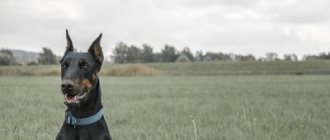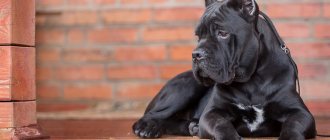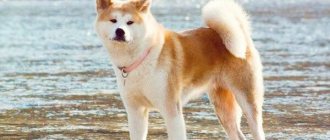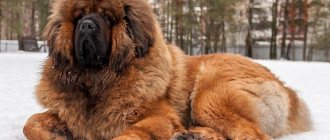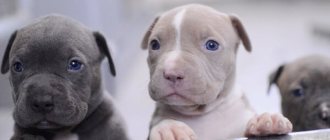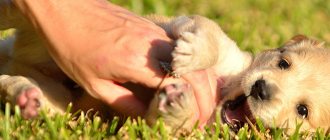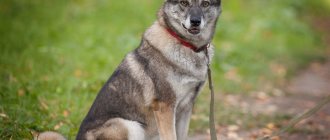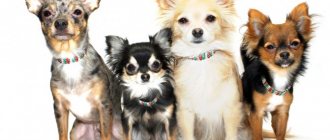Dogs grow and develop very quickly. From the moment of birth to the formation of an adult dog, about a year passes. Therefore, it is very important to know how the puppy develops month by month in the first year of life, what stages of socialization it goes through. This will help ensure proper care, good physical health and upbringing.
First two weeks
Puppies are completely dependent on their mother for the first two weeks. Immediately after birth and in the next few days, they still do not see or hear. Their movement is based on reflexes - they only look for a source of heat, which is the bitch, in order to eat. At this stage, the person's role is to monitor the feeding process.
All babies should have equal access to nipples. This is very important when the litter is large and there are not enough nipples for all the babies. As a rule, the stronger ones start feeding first, and those who are weaker may simply not have enough milk.
Experienced breeders advise dividing puppies into two groups and applying the weaker ones to the nipples first.
In addition, it is necessary to ensure optimal temperature conditions for the bitch with a litter. Babies have very poor thermoregulation and can become hypothermic. It is best to prepare a “house” with a convertible top for a dog family. This design allows easy access and allows you to regulate the temperature inside.
Make sure that the bitch does not accidentally crush the babies during sleep or that they do not crawl far away from her. Puppies should not be separated from their mother for several days after birth; it is best not to disturb them. Too much attention can irritate the bitch, and babies don't need human contact yet. Only in the second week can you gently stroke them or pick them up.
Important: do not take puppies away from the bitch for a long time.
Food selection
The issue of choosing a feeding system has always been and remains controversial. Among dog breeders and owners there are both ardent supporters of natural feeding and adherents of feeding dry food.
NOTE!
There are also compromise opinions, for example, the head of the Russian retriever club believes that it is not so important which of the schemes to choose, but what is important is to do it competently - watch your pet, monitor the condition of its fur, ears, for signs of allergies.
If the coat is shiny, there are no allergies, the dog is in normal condition, is not losing weight, but is not gaining excess weight, then the chosen feeding option is suitable for the puppy.
It goes without saying that when it comes to choosing dry food, the food must be of high quality. If preference is given to natural food, then a competent approach is needed, a careful selection of ingredients and their volume.
The third and fourth weeks - the beginning of socialization
In the third week of life, puppies already see well and are already beginning to hear. They are still dependent on their mother and feed only on her milk, but they are already starting to play with their brothers and sisters, trying to lick and bite different objects.
During this period, their baby teeth appear. Puppies test their severity on their siblings, biting each other as they play.
This is a natural behavior through which they learn to play with other animals without harming them.
At this stage of development, the puppy's contact with people becomes very important. The dog needs to be petted and picked up. This must be done carefully and make sure that the kids have only pleasant emotions.
If a puppy is separated from his dam and siblings at this stage of his life, he may become overly aggressive in the future and have difficulty interacting with other animals. In turn, the lack of human contact or the presence of negative stimuli that cause anxiety and pain can make an adult dog fearful or not receptive to affection.
Basic feeding rules
Below are the basic nutrition rules:
- The first and basic rule of feeding: you choose only “natural” food for your puppy or stick to dry food. You can’t mix feeding systems: it can cause gastrointestinal upset.
- The second rule: whether it is natural food or dry food, it must be high-quality food with a full menu and good, high-quality premium, super-premium or holistic food.
- Nutrition should be balanced in the content of proteins, fats and carbohydrates. It should contain a sufficient amount of fiber, minerals and other substances.
- Regular feeding is important, i.e. Feeding should be done at approximately the same time.
- The owner of the puppy should have an idea of what foods are prohibited or restricted for consumption by puppies and adult dogs. This is any expired food, stale food, spices, smoked foods, sweets. Pork and lamb should be limited.
CAREFULLY!
Dogs are not allowed chocolate. It can cause thirst and diarrhea, and can sometimes even lead to death.
Weeks 5 and 6 - Play and Learn
The puppy continues to actively develop. During this period, he begins to grow quickly, willingly makes his first “forays” from his mother, and learns about the world. He is curious, full of energy and craves entertainment. Each puppy needs a lot of attention - this is the only way to ensure that in the future he will not have problems communicating with people.
Around the sixth week, after sleeping and eating, it is worth placing the puppies in a specially designated area where they can take care of their physiological needs (although it is still too early for them to walk on their own).
Some breeders give away puppies as early as six weeks of age. However, this is too early - an animal at this stage of development still needs mother's milk and the company of its relatives.
Feeding dry food
If you decide in favor of dry food, it is very important to choose it correctly.
The food of all self-respecting companies is divided into several groups according to energy value, content of vitamins and minerals and takes into account the needs of dogs of different ages. For example, there are special foods for large breed puppies.
There is usually a table on the food bag with information about how many grams of food you should give your puppy per day.
There are a huge number of feed manufacturers, here everyone chooses for themselves. It is advisable to buy food of at least premium class.
The following foods have proven themselves to be effective:
- Monge;
- GO!;
- Hills;
- Brit;
- Bosh;
- Happy Dog;
- Royal Canin.
The seventh and eighth weeks - the beginning of independence
At the turn of the seventh and eighth weeks (the exact time depends on the breed), the dog begins to become independent. He may already be taking food other than his mother's milk. At this stage, the puppy’s development has already reached the stage where it can be given to a new owner.
It is believed that it is best to give puppies away at 8-11 weeks of age. During this period, they easily adapt to new conditions.
You should spend a lot of time with your dog at this stage of development. First of all, he should be taught hygiene. If possible, immediately after sleeping or eating, take him outside and sit him on the grass so that he has the opportunity to go to the toilet.
The time for full training has not yet come, but the general rules of behavior need to be explained. If, for example, you do not want your dog to climb on the bed in the future, never put your puppy on it.
The main rule is never allow a puppy to do anything that is prohibited for an adult dog!
In the first days after being separated from his canine family, the baby will be very bored. Therefore, he needs to pay a lot of attention. Make sure his place is warm, with a soft blanket and some sort of toy he can cuddle. Be prepared for the fact that in the first nights he will “cry” and look for his mother’s warm side. In this case, a heating pad or a water bottle wrapped in a towel will help.
To reduce the trauma of separation, breeders give the puppies along with his favorite toy, which still has a “native smell” on it. This makes the dog feel safer.
How to teach a puppy to the “Come to me” command?
Be in the center of the puppy's attention all the time with the help of treats, a favorite toy, and an exciting game. Walk him along unfamiliar routes, where the puppy will not behave so confidently and, accordingly, will not lose sight of you.
Training a puppy and its adoption of good behavior patterns should begin before he begins his own upbringing.
Your growing friend has already learned to clearly distinguish between friends and strangers. Moreover, he often shows a distrustful attitude towards strangers. This behavior is highly desirable and should be encouraged. But it is necessary to stop the dog from showing too much irritation when strangers appear, since the dog must be adapted to life in society. You can learn about the behavioral characteristics and nuances of raising a dog depending on the breed here.
It is worth noting that until recently, when an adult dog approached, your puppy assumed a pose of submission, and with his peers started a fun romp that did not turn into a showdown. But now everything is different. The growing puppy begins to show the first signs of behavior caused by the instinct of territoriality. He already clearly distinguishes between friends and strangers, making attempts to drive the latter away from his familiar territory, which inevitably leads to conflict situations.
This dog behavior should not be encouraged, much less provoked. Otherwise, feeling her strength, she will rush at all unfamiliar dogs. And this greatly overshadows the joy of walking together.
You should also train your dog to be in your field of vision. While walking, your pet may become very interested in new smells and simply not hear your commands. Therefore, before you call, attract his attention with a sharp sound (a whistle, a snowball or stick thrown near him, etc.). For following the command, be sure to give the puppy a dog treat.
The third month is the intensive development of the puppy
Around the ninth - eleventh week, the dog remembers everything very easily. This is the best time to start training. The baby strives to understand the world around him; he, like a sponge, absorbs all the information and quickly learns everything. And he does it with pleasure, perceiving it as an entertaining game.
When training your dog, never use a system of punishment for unwanted behavior. The physical punishment and pain that the puppy feels can remain in his memory for the rest of his life. This will affect his attitude towards the owner and people in general.
The owner's requirements must be consistent and understandable, otherwise the animal will not learn the rules of the house. You can now take your baby with you for a walk. During which you need to stroke him often and play with him. Training sessions should not be long in time. Focus on your pet. Work on teaching commands as long as he is focused. Always reward your student for every exercise performed correctly.
What complex exercises should you use?
Let the puppy stand next to you. Alternately give the commands “Stand”, “Lie down”, “Sit”, using different sequences.
Does your puppy refuse to sit on command? Repeat the command (the intonation is threatening), and press on the dog’s lower back with one hand. With your other hand, grab the leash just behind the collar and pull back. Then you can reward the puppy.
Does the puppy not accept the command “Lie down”? Repeat it with a threatening intonation and put the puppy down. To do this, pull the dog's front legs forward with one hand, and with the other hand press on the withers. Then reward the puppy.
Puppy won't get up when commanded "Stay"? Give the command again, using a threatening intonation. Hold the dog's collar with one hand and lift it with the other, supporting it under the belly.
Puppy development in the fourth month - hierarchy phase
A puppy at the twelfth or thirteenth week of life will chew everything that gets into its teeth. The best way to protect shoes and furniture is to give him access to the right toys and teethers. During this period, there is already a close connection between him and the owner. Despite this, the dog may try to test his owner's patience: for example, by running away during a walk or ignoring orders. Firmness, calmness, consistency and regular training are the keys to taming the dog’s temperament and showing him who is the leader in the “house pack”.
The dog by its nature is a herd animal, so it is imperative to establish a hierarchy. Clear rules must be established and followed. When issuing commands, it's not so much the volume as the tone of voice. In addition, short commands should be combined with clear gestures. Always use a specific command and gesture combination.
If the dog was raised for up to three months with its relatives, the hierarchy has already been established. If he was excommunicated earlier, and he lives only surrounded by people, then he will definitely fight with them for power. During this time, clear boundaries must be set and respected if you want to have authority over the puppy.
As a dog owner, you must remain adamant when he wants to take over people.
Don't let your pet lie on the couch, walk through the door in front of you, or hang around you waiting for food. Make it clear to your dog what you expect from him and put him in his place. Consistency and distancing with dividers is extremely important. Your pet will understand that you are the leader of the pack and will happily obey the established rules.
Teach your puppy to overcome horizontal and vertical obstacles
At the first stage, walk the puppy on a short leash. Find a log lying on the ground (diameter 12-15 cm), command “Barrier”. Step over the log while pulling the puppy along with you. Let him lean on the log with his paws. When the puppy jumps over the log, tell him “Okay!”, pet him and give him a treat. Wait a little and repeat everything from the beginning 2-3 times.
In the second stage, successively increase the height of the obstacle to 1 meter. If you have a very small dog, stop at 50 cm. You should go around the obstacle rather than jump over it.
At the third stage, you will teach the puppy to jump unsupported over an obstacle. To do this, a thin wooden strip is installed on stands, the height of which is 12-15 cm. Jump over the obstacle, and drag the puppy along with you on a short leash. When your pet makes a jump, give him a treat, praise and pet him. By five months, the puppy should be able to jump over obstacles up to 30 cm high without support, and for small breed dogs - 20 cm.
At the fourth stage, the puppy learns to overcome horizontal obstacles. The training scheme is the same as for vertical obstacles. Only the length of objects should be 10 cm greater than the length of vertical obstacles.
5-6 months - environmental awareness
At this time, the dog begins to expand its living space and remember it. Now you need to consolidate the previously learned rules of communication and behavior. If the baby was separated from its mother at the age of 3-4 months, then it has well learned species-specific social behavior. He knows well how to behave with adult animals, when to play and when not to. Can “read” the sign language of its relatives. All that remains is to secure it.
If the puppy was taken early, the owner himself must teach him the rules of behavior with other dogs. Under no circumstances should it be isolated. He must communicate with his own kind. Socialization is a very important stage. If you miss it, it may affect the psychological state of the mature dog. This can be expressed in fearfulness or aggression at the sight of strange animals, in panic or depression in the absence of the owner. Between 5 and 6 months the dog becomes independent and requires a firm hand to get through the rebellious period of puberty.
Feeding with natural food
Feeding natural food, of course, takes a lot of time and effort. And we must understand that natural food is not about porridge in meat broth with pieces of meat or table waste, as some people believe. Such feeding will not add health to any dog, let alone a puppy.
For each dog, the diet is prepared individually. The following products are mainly used for cooking:
- meat (raw, boiled), meat broths;
- offal (2-3 times a week);
- cereal;
- sea fish;
- milk and dairy products (cottage cheese, yogurt);
- fruits and vegetables, herbs.
It is advisable to give additional vitamins to a naturally fed puppy. A puppy at this age is fed 3 times a day.
It is also recommended to give a natural puppy 1 egg every 2-3 days.
Approximate weekly diet for a puppy:
| Days of the week | Morning | Day | Evening |
| Mon | Meat, 600 g | Buckwheat, 400g, vegetables and herbs, 200g, salt 5g | Cottage cheese, 500 g |
| W | Fish,600g | Rice, 400 g, vegetables and herbs, 200 g, salt 5 g | Yogurt, 500 g |
| Wed | Meat, 600 g | Buckwheat, 400g, vegetables and herbs, 200g, salt 5g | Cottage cheese, 500 g, egg, 1 pc. |
| Thu | Meat, 600 g | Rice, 400 g, vegetables and herbs, 200 g, salt 5 g | Yogurt, 500 g |
| Fri | Meat, 600 g | Buckwheat, 400g, vegetables and herbs, 200g, salt 5g | Cottage cheese, 500 g |
| Sat | Meat, 600 g | Rice, 400 g, vegetables and herbs, 200 g, salt 5 g | Yogurt, 500 g |
| Sun | By-products, 600 g | Buckwheat, 400g, vegetables and herbs, 200g, salt 5g | Cottage cheese, 500 g, egg, 1 pc. |
Learning to walk
The main thing in the ability to walk is for the puppy to calmly react to stimuli, not get scared, not jump out onto the roads and move clearly at the owner’s left foot. Does your puppy break from its leash? Pull the leash and command “Quiet!” Does not help? Repeat the command and lightly tug the leash. Didn't help again? Say “Here” and let your puppy follow the command. Later, you can release the puppy by giving the command “Walk.” There is no need to accompany the command with a gesture, since the gesture allows the dog to move away from the owner. The command simply lets the dog know that it is forbidden to move away from the owner, you can only change position.
It is very important that the puppy learns to cross roads correctly. Before stepping onto the roadway, give the command “Nearby”. Is the puppy trying to get off the road on its own? Command “Come to me!” and use a tug on the leash to return the dog to the sidewalk. Read more "

